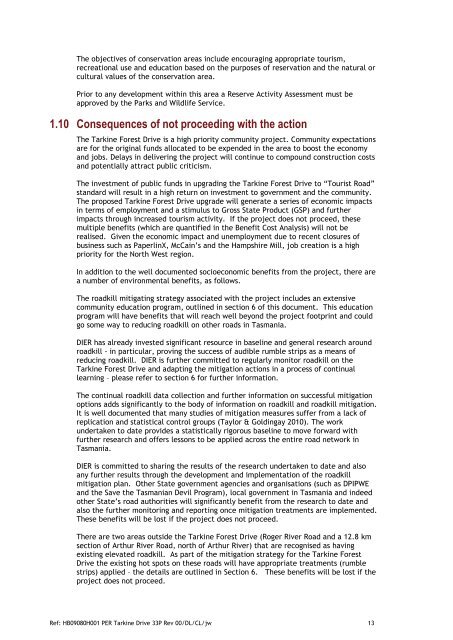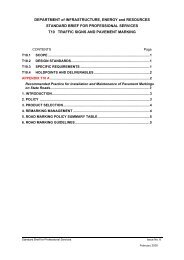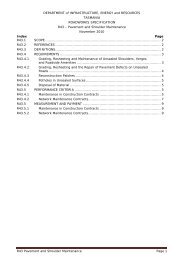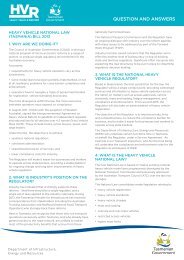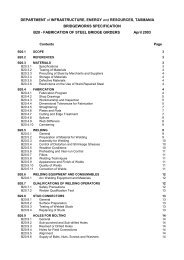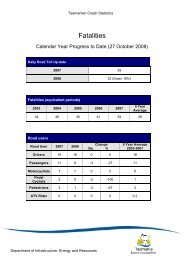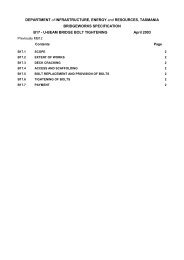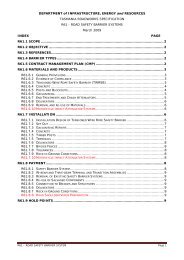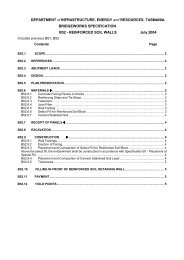Public Environment Report Tarkine Forest Drive ... - Transport
Public Environment Report Tarkine Forest Drive ... - Transport
Public Environment Report Tarkine Forest Drive ... - Transport
- No tags were found...
Create successful ePaper yourself
Turn your PDF publications into a flip-book with our unique Google optimized e-Paper software.
The objectives of conservation areas include encouraging appropriate tourism,recreational use and education based on the purposes of reservation and the natural orcultural values of the conservation area.Prior to any development within this area a Reserve Activity Assessment must beapproved by the Parks and Wildlife Service.1.10 Consequences of not proceeding with the actionThe <strong>Tarkine</strong> <strong>Forest</strong> <strong>Drive</strong> is a high priority community project. Community expectationsare for the original funds allocated to be expended in the area to boost the economyand jobs. Delays in delivering the project will continue to compound construction costsand potentially attract public criticism.The investment of public funds in upgrading the <strong>Tarkine</strong> <strong>Forest</strong> <strong>Drive</strong> to “Tourist Road”standard will result in a high return on investment to government and the community.The proposed <strong>Tarkine</strong> <strong>Forest</strong> <strong>Drive</strong> upgrade will generate a series of economic impactsin terms of employment and a stimulus to Gross State Product (GSP) and furtherimpacts through increased tourism activity. If the project does not proceed, thesemultiple benefits (which are quantified in the Benefit Cost Analysis) will not berealised. Given the economic impact and unemployment due to recent closures ofbusiness such as PaperlinX, McCain’s and the Hampshire Mill, job creation is a highpriority for the North West region.In addition to the well documented socioeconomic benefits from the project, there area number of environmental benefits, as follows.The roadkill mitigating strategy associated with the project includes an extensivecommunity education program, outlined in section 6 of this document. This educationprogram will have benefits that will reach well beyond the project footprint and couldgo some way to reducing roadkill on other roads in Tasmania.DIER has already invested significant resource in baseline and general research aroundroadkill - in particular, proving the success of audible rumble strips as a means ofreducing roadkill. DIER is further committed to regularly monitor roadkill on the<strong>Tarkine</strong> <strong>Forest</strong> <strong>Drive</strong> and adapting the mitigation actions in a process of continuallearning – please refer to section 6 for further information.The continual roadkill data collection and further information on successful mitigationoptions adds significantly to the body of information on roadkill and roadkill mitigation.It is well documented that many studies of mitigation measures suffer from a lack ofreplication and statistical control groups (Taylor & Goldingay 2010). The workundertaken to date provides a statistically rigorous baseline to move forward withfurther research and offers lessons to be applied across the entire road network inTasmania.DIER is committed to sharing the results of the research undertaken to date and alsoany further results through the development and implementation of the roadkillmitigation plan. Other State government agencies and organisations (such as DPIPWEand the Save the Tasmanian Devil Program), local government in Tasmania and indeedother State’s road authorities will significantly benefit from the research to date andalso the further monitoring and reporting once mitigation treatments are implemented.These benefits will be lost if the project does not proceed.There are two areas outside the <strong>Tarkine</strong> <strong>Forest</strong> <strong>Drive</strong> (Roger River Road and a 12.8 kmsection of Arthur River Road, north of Arthur River) that are recognised as havingexisting elevated roadkill. As part of the mitigation strategy for the <strong>Tarkine</strong> <strong>Forest</strong><strong>Drive</strong> the existing hot spots on these roads will have appropriate treatments (rumblestrips) applied – the details are outlined in Section 6. These benefits will be lost if theproject does not proceed.Ref: HB09080H001 PER <strong>Tarkine</strong> <strong>Drive</strong> 33P Rev 00/DL/CL/jw 13


